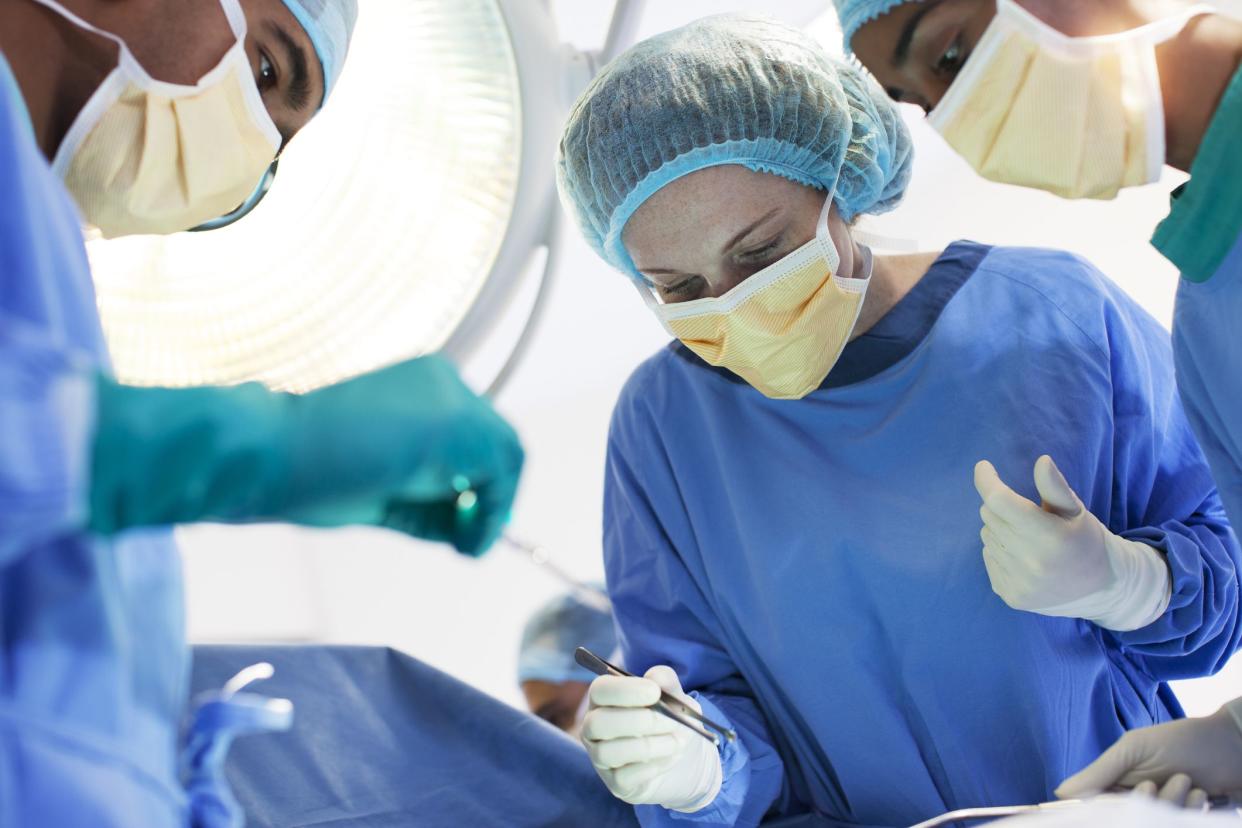

airdone/iStock
Fatty liver disease
Fatty liver disease occurs when fat builds up in your liver. This can cause damage, inflammation and other complications.
There are two main types of fatty liver disease:
-
Non-alcoholic fatty liver disease (NAFLD). As the name suggests, this type of fatty liver disease is not caused by drinking alcohol.
-
Alcoholic fatty liver disease. This is also called alcoholic steatohepatitis. It is caused by heavy alcohol consumption.
It is possible to have both types of fatty liver disease at the same time.
About one in four people worldwide have non-alcoholic fatty liver disease. It is the most common cause of liver disease in the United States.
NAFLD is further divided into two types:
-
Non-alcoholic fatty liver disease (NAFL). Also called hepatic steatosis or simple fatty liver disease, this occurs when there is too much fat in the liver, but minimal inflammation or damage to the liver cells.
-
Nonalcoholic steatohepatitis (NASH). With this type of fatty liver disease, you have fat in your liver, inflammation and damage to the liver cells. This can lead to cirrhosis (liver scarring) and liver cancer.
Most people with NAFLD have nonalcoholic steatohepatitis. Healthcare professionals aren’t sure why some people develop nonalcoholic fatty liver disease while others develop NASH.
If you have fatty liver disease, you are more likely to develop health problems such as:

Prostock Studio / iStock
Symptoms of fatty liver disease
Fatty liver disease is known as a ‘silent disease’ because it has few symptoms.
You may even have fatty liver disease without even knowing it. You may not experience any symptoms at all until it causes health problems.
If symptoms are present, they may include fatigue and discomfort in the upper right part of your abdomen.
In very severe cases, as the condition progresses you may experience:
If fatty liver disease leads to cirrhosis, you may experience:
-
Fatigue
-
Weakness
-
Nausea
-
Loss of appetite
-
Weight loss
-
Swelling
-
Jaundice

Adobe
Causes of fatty liver disease
It is unclear what exactly causes fatty liver disease if it is not caused by alcohol.
Possible causes may include:
Alcoholic fatty liver disease is caused by drinking too much alcohol over an extended period of time.

Rostislav_Sedlacek / iStock
Risk factors for fatty liver disease
Being overweight or obese is a major risk factor for fatty liver disease. Estimates suggest that up to 75 percent of the people overweight people have NAFLD, and more than 90 percent of people with severe obesity have the condition.
The risk factors for alcoholic fatty liver disease include heavy drinking, especially if you have been drinking heavily for a long time.
Among those who drink heavily, you are at higher risk for fatty liver disease if you:
-
Being obese
-
Are feminine
-
Have certain genes
Other risk factors for nonalcoholic fatty liver disease include:
-
Prediabetes (Read more about Prediabetes.)
-
Type 2 diabetes
-
Obesity
-
High blood pressure
-
Be high cholesterol or triglycerides
-
Metabolic syndrome
-
Fast weight loss
-
Infections such as hepatitis C
-
Some medications
-
Exposure to toxins
-
Age
-
Ethnicity (you are more likely to develop NAFLD if you are Hispanic)

Halfpoint/istock photo
Diagnosis of fatty liver disease
Fatty liver disease can be easy to miss because many people experience no symptoms. If you have a liver function test for any other reason, your healthcare provider may notice abnormal results and want to check for fatty liver disease.
To start, your healthcare provider may ask you about your medical history. These may be questions about:
We know it can be awkward to talk about your drinking habits, but it’s important to be honest here.
Your healthcare provider is not here to judge, but only to help you take charge of your health. They need an accurate picture of how much alcohol you drink to diagnose and treat fatty liver disease.
Your healthcare provider may then perform a physical examination. This may include checking your eyes for signs of jaundice. They may feel your abdomen to see if it is painful or enlarged.
Your provider may also order tests to diagnose fatty liver disease.
These tests may include:
-
Blood test
-
Imaging tests
-
A liver biopsy

pcess609/Istockphoto
Treatment of fatty liver disease
The type of treatment you need for fatty liver disease depends on the type you have. Below are some common treatments.

DepositPhotos.com
Weight loss
If you are overweight or obese, your healthcare provider may recommend weight loss to help manage nonalcoholic fatty liver disease.
Losing weight can help reduce steatosis (fat buildup), inflammation, and fibrosis (thickening or scarring in the liver).
Research suggests that losing three to five percent of your body weight can improve fat build-up, while losing 10 percent can reduce liver inflammation.
If you lose weight, your NASH may switch to NAFL. That is, liver inflammation and damage improve, but there is still a buildup of fat in your liver.
If you have had trouble maintaining weight in the past, your provider may recommend weight loss medications.
These include:
-
Semaglutide (Ozempic®, Wegovy®, Rybelsus®, compound semaglutide)
-
Tirzepatide (Mounjaro®, Zepbound®, compound tirzepatide)
-
Liraglutide (Victoza® and Saxenda®)
-
Metformin
-
Topiramate
Weight loss is highly individualized, so it’s best to talk to a healthcare provider who can give you personalized advice about achieving your goals – and what those goals should look like.
To achieve your weight loss goals, you can also try the following:
-
Making healthy food choices. Reach for fruits, veggies, lean egg whitelegumes and whole grains such as brown rice and whole wheat bread.
-
Drink less. Alcohol contains a lot of calories and… contributes to weight gain.
-
Get more activity. Make regular activity a habit. This can be structured exercise such as exercise classes or general exercise, such as walking more every day. (Learn more about What is the best sport to lose weight?.)
-
Drink more water. Water can make you feel fuller promote the breakdown of fat.
-
Prioritize sleep. Goal for seven to nine hours of sleep one night. Maintaining a regular sleep schedule, drinking less caffeine, and maintaining a relaxing bedtime routine can help you get more shut-eye.

DepositPhotos.com
Medication for fatty liver disease
Your healthcare provider may recommend medications for fatty liver disease.
These include:
In March 2024the U.S. Food and Drug Administration (FDA) has approved resmetirom – sold under the brand name Rezdiffra® – for people with NASH and moderate to advanced liver scarring.
In clinical trials, Rezdiffra helped improve liver scarring or clear NASH after 12 months.
Weight loss injections such as semaglutide have also been found to directly improve fatty liver disease.
A Systematic review from 2023 examined three clinical trials involving nearly 460 participants with NAFLD. Findings suggest that semaglutide helped improve participants’ liver health.
Those who took semaglutide were more likely to have their NASH resolve compared to those who took a placebo.
Semaglutide led to improvements in:

PixelsEffect/istockphoto
Eliminate alcohol
For alcoholic liver disease, treatment includes quitting alcohol.
You can do this by:
-
Get support from a therapist, addiction specialist, or support group.
-
Talking to a healthcare provider about medications that can help curb alcohol cravings.
-
Stop drinking together with a good friend or family member.
-
Avoiding triggers: These could be certain places, people or times when you often drink.
-
Make lifestyle changes, such as finding a new hobby, exercising, or adopting a new exercise routine.
-
Replace alcoholic drinks with sparkling water or mocktails.

Sam Edwards/istockphoto
Other treatments
If your NAFLD is caused by a certain drug, you may be advised to stop taking this drug. Your healthcare provider will give you instructions on how to stop your medication and whether to start an alternative treatment.
Depending on the severity of your condition, you may need further treatment. For example, fatty liver disease can lead to cirrhosis. Cirrhosis can cause serious health problems that require medications, surgery, or even a liver transplant.

ImperfectProduce.com
Tips for preventing fatty liver disease
To reduce your risk of developing fatty liver disease, try to maintain a healthy weight and limit your alcohol consumption.
Other steps you can take include:
-
Follow a healthy diet. Focus on eating mostly fruits, vegetables, legumes, fish and whole grains. The Mediterranean diet and the DASH eating plan are good examples of healthy eating.
-
Getting regular physical activity. Aim for a mix of cardio and strength training.
Stay on top of your health. Consult your doctor regularly to limit the risk factors for your fatty liver disease.
This article originally appeared on Hims.com and was syndicated by MediaFeed.org.

Shidlovski / iStock